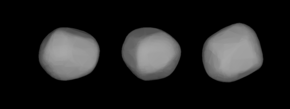 A three-dimensional model of 423 Diotima based on its light curve | |
| Discovery | |
|---|---|
| Discovered by | Auguste Charlois |
| Discovery date | 7 December 1896 |
| Designations | |
| (423) Diotima | |
| Pronunciation | /daɪ.əˈtaɪmə/[1] |
Named after | Diotima of Mantinea (Διοτίμα Diotīma) |
| 1896 DB | |
| Main belt | |
| Adjectives | Diotimean /daɪ.ɒtəˈmiːən/, Diotimian /daɪ.əˈtɪmiən/ |
| Orbital characteristics[2] | |
| Epoch 31 July 2016 (JD 2457600.5) | |
| Uncertainty parameter 0 | |
| Observation arc | 116.96 yr (42719 d) |
| Aphelion | 3.18523 AU (476.504 Gm) |
| Perihelion | 2.95026 AU (441.353 Gm) |
| 3.06774 AU (458.927 Gm) | |
| Eccentricity | 0.038297 |
| 5.37 yr (1962.6 d) | |
| 237.495° | |
| 0° 11m 0.355s / day | |
| Inclination | 11.2304° |
| 69.4710° | |
| 200.103° | |
| Physical characteristics | |
| Dimensions | 171 km × 138 km[3] |
| 175.859±3.854 km[2] 211.64 ± 16.02 km[4] | |
| Mass | (6.91±1.93)×1018 kg[4] (4.368 ± 1.680/1.377)×1018 kg[5] |
Mean density | 1.39 ± 0.50 g/cm3[4] 1.534 ± 0.590/0.483 g/cm3[5] |
| 4.775 h (0.1990 d)[2] | |
| 0.067±0.015[2] | |
| C[2] | |
| 7.42[2] | |
423 Diotima is one of the larger main-belt asteroids. It is classified as a C-type asteroid[2] and is probably composed of primitive carbonaceous material.
It was discovered by Auguste Charlois on 7 December 1896, in Nice. In the late 1990s, a network of astronomers worldwide gathered lightcurve data that was ultimately used to derive the spin states and shape models of 10 new asteroids, including 423 Diotima. The light curve for this asteroid varies "a lot" depending on the position, with the brightness variations ranging from almost zero to up to 0.2 in magnitude.[6][7] Dunham (2002) used 15 chords and obtained an estimated size of 171 km × 138 km.[3]
- ^ Noah Webster (1884) A Practical Dictionary of the English Language
- ^ a b c d e f g Cite error: The named reference
jpldatawas invoked but never defined (see the help page). - ^ a b Vasundhara, R; Kuppuswamy, Ramamoorthy; Velu, Venkataramana (2006). "Occultation of 2UCAC 42376428 by (423) Diotima on 2005 March 06". Astronomical Society of India. 34: 21–26. Retrieved 30 November 2008.
- ^ a b c Cite error: The named reference
Carry2012was invoked but never defined (see the help page). - ^ a b Cite error: The named reference
FiengaEtAl2020was invoked but never defined (see the help page). - ^ Cite error: The named reference
Durech2007was invoked but never defined (see the help page). - ^ Durech, J.; Kaasalainen, M.; Marciniak, A.; Allen, W. H. et al. "Asteroid brightness and geometry," Astronomy and Astrophysics, Volume 465, Issue 1, April I 2007, pp. 331-337.